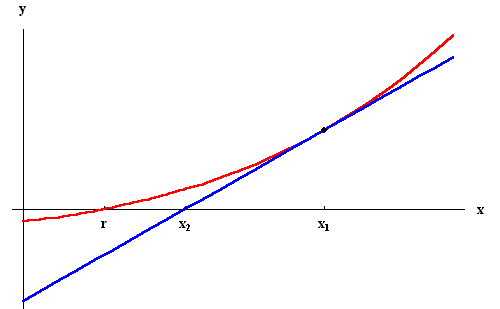Newton-Raphson方法
2015-08-02 20:33
501 查看

The Newton-Raphson Method
Already the Babylonians knew how to approximate square roots. Let's consider the example of how they found approximations to
.
Let's start with a close approximation, say x1=3/2=1.5. If we square x1=3/2, we obtain 9/4, which is bigger than 2. Consequently

.
If we now consider 2/x1=4/3, its square 16/9 is of course smaller than 2, so

.
We will do better if we take their average:

If we square x2=17/12, we obtain 289/144, which is bigger than 2. Consequently

.
If we now consider 2/x2=24/17, its square 576/289 is of course smaller than 2, so

.
Let's take their average again:

x3 is a pretty good rational approximation to the square root of 2:

but if this is not good enough, we can just repeat the procedure again and again.
Newton and Raphson used ideas of the Calculus to generalize this ancient method to find the zeros of an arbitrary equation

Their underlying idea is the approximation of the graph of the function f(x)
by the tangent lines, which we discussed in detail in the previous pages.
Let r be a root (also called a "zero") of f(x), that is f(r) =0. Assume that

.
Let x1 be a number close to r (which may be obtained by looking at the graph of f(x)). The tangent line to the graph of f(x) at (x1,f(x1)) has x2 as
its x-intercept.
 |

Since we assumed

,
we will not have problems with the denominator being equal to 0. We continue this process and find x3 through
the equation

This process will generate a sequence of numbers

which
approximates r.
This technique of successive approximations of real zeros is called Newton's method, or the Newton-Raphson Method.
Example. Let us find an approximation to

to ten decimal places.
Note that

is an irrational number. Therefore the sequence of decimals which defines

will
not stop. Clearly

is the only zero of f(x) = x2 - 5 on the interval [1,3]. See the
Picture.
 |

be the successive approximations obtained through Newton's method. We have

Let us start this process by taking x1 = 2.

It is quite remarkable that the results stabilize for more than ten decimal places after only 5 iterations!
Example. Let us approximate the only solution to the equation

In fact, looking at the graphs we can see that this equation has one solution.
 |

. So now we see how
Newton's method may be used to approximate r. Since r is between 0 and

, we set x1=
1. The rest of the sequence is generated through the formula

We have

相关文章推荐
- Service和Thread的关系
- win8.1通过update升级win10的一些问题和思考
- Spring AOP之AspectJ
- Android开源框架(一):AndroidAnnotations
- ucp2p ,一个简单的P2P库
- C++常用容器总结
- C++字符串总结
- 十佳最受欢迎的编程语言,你擅长几个?
- 在Github上搭建自己的博客网站
- 烧钱时代,产品经理该做什么?
- HDOJ 2570 迷瘴(贪心)
- 69. Sqrt(x)
- MySql学习:索引
- [leetcode] permutations的讨论
- C语言 -- 定时关机程序
- 【Qt OpenGL教程】07:光照和键盘控制
- Search in Rotated Sorted Array
- 各种数据类型
- 我认识的七个理想主义者
- Chrome 控制台 如何调试 javascript
